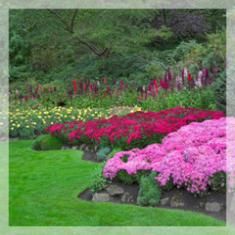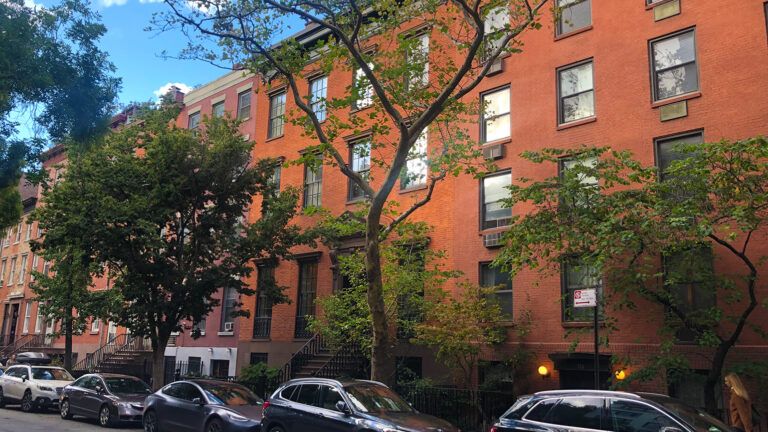In my earliest memories I’m in my grandmother’s yard in Steubenville, Ohio, reaching out to touch the soft petals of flowering phlox in lavender, rose and snowy white. She holds my hand as we walk along what we called “hollyhock alley” and sing a favorite hymn: “I come to the garden alone while the dew is still on the roses….”
Everything around me—the rustling leaves, the loamy scent of newly turned earth, the warmth of my grandmother’s attention—assures me that this is a kind of sacred place. Is it any wonder that all my life I’ve made gardens for myself wherever I have lived?
My first apartment was a second-floor Manhattan walkup that looked out onto an air shaft. No light, no soil. I bought an aluminum stand with fluorescent lights to grow marigolds and geraniums.
My next place, and current home, was an apartment with a terrace and river view. I could have a garden here. Only problem: the place was 17 blustery floors up.
I had a carpenter build sturdy planters and I picked up flats of impatiens and zinnias at street fairs, and ordered hardy rose bushes to withstand the city’s whipping winds.
I have to kneel on a narrow swath of brick to work my hands in the soil but when I do, I feel as I did when I was a child. No matter where your garden grows, it enriches your life. Here are some ways how:
Take root.
One night, years ago, while working at a woman’s magazine, I was ready to send off the glossy “Manhattan edition” I edited every month. The publisher rushed in to announce we’d be adding more pages so we needed more articles—fast. Near dawn I finally got home. I was exhausted and missing my family’s garden.
I tossed and turned in bed, fretting. Please help me to calm down, I prayed. Then the pearly glow of first light appeared.
I sat up groggily and noticed the cardboard box that had arrived in the mail the day before. Plants I’d ordered from a catalog! I took the box out to the terrace and tore it open. I tapped the begonia and hollyhock plants out of their containers, tucked them into dirt-filled window boxes and watered.
With the sun at my back and my hands in the soil, I felt connected to the things that really matter, and my worries evaporated like the morning dew.
As I worked, I felt my heartbeat slow down, my body relax, my whole being become quiet and soften. Home is where my garden is, I thought.
A flier in the box caught my eye. “DEVELOP A STRONG ROOT SYSTEM,” it said in bold letters. That’s what a garden does for you, I thought. Keeps you rooted in your values, rituals, traditions. I planted and tended those plants, giving them all the nourishment they needed. And in return, they nourished me spiritually.
Embrace the season.
Nothing compares to the excitement spring brings to a gardener. My garden comes back to life, exuberantly. First, the sunny tops of daffodils poke up, and orange and pink tulips and then those grape hyacinths—how can anything so compact give off such tremendous perfume? Suddenly, my terrace is alive with color and fragrance.
Yet, not long after they appear, those first flowers wither. And year after year, it makes me sad. But by summer, there is new life in the garden: snapdragons and marigolds and the phlox that always bring Grandmother to mind.
Yes, to everything there is a season. We must adapt, grow and change. Instead of lamenting loss and wanting to control nature, I rejoice in each flower that blooms.
There are those times when I feel forlorn, like my roses in winter. I look out on the terrace and remind myself: A garden is never lifeless. Even in winter, when it looks like nothing is happening, life is at work—bulbs storing up energy for next spring, perennials resting, soil breaking down into rich mulch.
And as our gardens go through their seasons of change, so, too, do we, just waiting sometimes to understand the larger purpose in our lives. It will come, as sure as crocuses in spring.
Share the beauty.
My father cut flowers to give to neighbors—especially ones who were sick or feeling down—and for my mother to make centerpieces for her women’s club and choir dinners.
“Why don’t you just leave them in the garden?” I asked, secretly thinking, for me to enjoy.
My dad looked surprised. “We need to pass the pleasure on,” he said.
Dad was right. There’s nothing like a gift from the garden. Guideposts readers have sent me seeds and cuttings from all over the country. I’ve been given bluebonnet seeds from Texas and wisteria tendrils from South Carolina. I have hollyhocks and a nonstop patch of mint from my hometown.
From my own Manhattan neighborhood are violets I dug up years ago from the courtyard of an about-to-be-demolished church. Among this growth and activity, bumblebees and butterflies drift by, and my upstairs neighbor Annie opens her apartment window. “Looks great, Mary Ann!” she calls from above. All of these sweet growing things connect me to a community.
I might live alone, but I never feel lonely in my garden. Digging, snipping, putting my face into a full-blown rose and breathing deeply, I think of how many others in Texas and Ohio and Oregon are doing the same. Gardening is a link to a wide world. The pleasure is multiplied when it’s shared.
Life will bloom again.
Thirteen years ago, my mother died of a heart attack. Next year at the same time my father died. My brother and sister and I dug roses and peonies from his garden to take to our own gardens.
The sadness in my heart seemed insurmountable as I unwrapped those plants, whose roots and stalks looked lifeless. Out on the terrace, I sat on the little wooden chair that my father always used when he was gardening, and put the knobby brown forms into pots.
By summertime, to my astonishment, they had put out breathtaking blossoms. One bush was covered with golden yellow roses, my mother’s favorite.
Stanley Kunitz, in his book The Wild Braid: A Poet Reflects on a Century in the Garden, writes: “The garden instructs us in the principle of life and death and renewal. In its rhythms, it offers the closest analogue to the concept of resurrection available to us.”
As much as I missed my parents, my sorrow was transformed by the scent of yellow roses.
It occurred to me that Jesus first appeared to Mary Magdalene after his crucifixion in a garden. What better place to be reminded that life blooms again and again?
Renewal is always at hand in a garden—be it a country meadow, a suburban yard, even a city windowsill—our own small patch of eternity.





